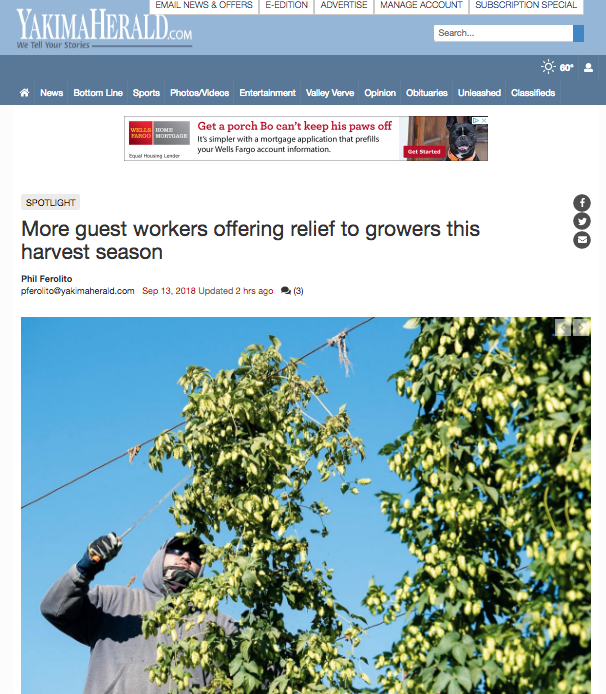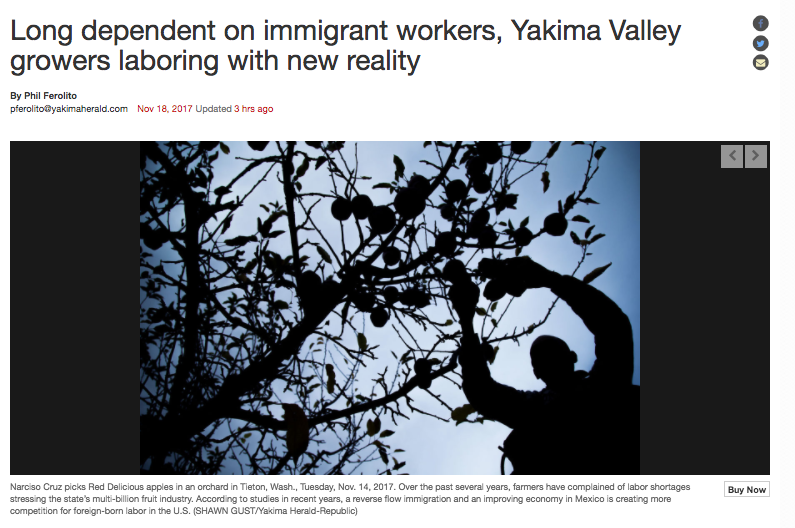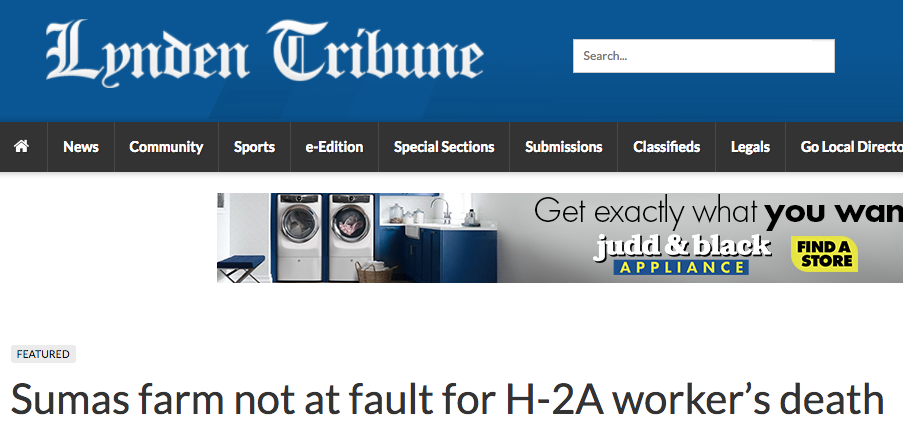Press reports relating to guest workers
Yakima herald: guest workers and fruit harvest |
Lynden tribune reports on worker march and false accusations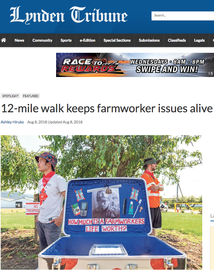
The Lynden Tribune reported on the August 5 worker march and, while giving considerable space to the false claims, also thankfully reported the fact that these claims are false.
Yakima herald reports on need for guest worker program changes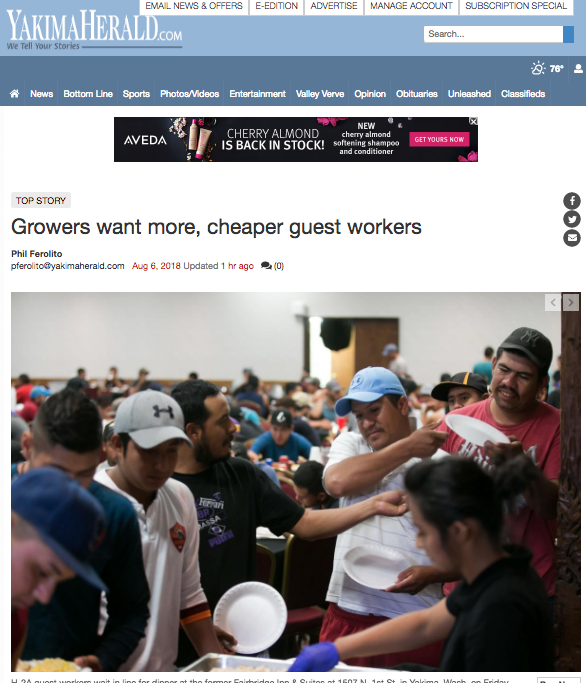
Yakima Herald reports on issues involving the current guest worker program and the need for significant improvements. The proposed changes will not only benefit farmers who need the workers, but workers who need the jobs and consumers who prefer the safer, more environmentally-friendly US grown food.
|
False claims on workers’ death persistLynden Tribune Guest Editorial
May 17, 2018 by Dillon Honcoop This is a guest column by Dillon Honcoop, who grew up on a Lynden-area raspberry farm and now works for Save Family Farming as coordinator of the Protect Farmworkers Now project. It’s important to tell the truth, especially when many people’s jobs and livelihoods are on the line. That’s why it’s so troubling to see activists and their sympathizers continue to spread an insidious lie in our community. Last summer, a worker at a Sumas blueberry farm was rushed to the hospital after having run out of his medication days earlier. Honesto Silva Ibarra tragically passed away at Harborview Medical Center in Seattle. An exhaustive Washington Department of Labor & Industries investigation reported that the farm was in no way responsible for Mr. Silva Ibarra’s death, but that truth is apparently an inconvenient one for activist labor groups like Bellingham-based Community to Community Development, which wanted to capitalize on news coverage of the tragedy to further their labor organizing efforts. They have falsely claimed that “degraded conditions” and management failure caused Mr. Silva Ibarra’s death, going so far as to label it “corporate murder,” and continuing to do so even after L&I’s investigation proved them wrong. A recent letter to the Tribune from a concerned citizen perhaps inadvertently continues this pervasive lie. “A young H2A worker died due to poor working conditions and management oversight,” Naomi Murphy wrote in the letter printed May 9. It’s one thing to express genuine concern for the workers, it’s another to continue to make false statements when the truth is out there for all to see. Either Ms. Murphy is entirely ignorant of the facts of the tragedy or she’s intentionally communicating false and harmful accusations. It’s deeply troubling that activist labor groups continue to claim in interviews, social media, website posts and elsewhere that, among other mistreatment of workers the Sumas farm caused the worker’s death. Their pressure on Labor & Industries and publicity they generated caused the department to issue a fine 40 times greater than one normally assessed for rest and meal break violations. It is shameful for a department to punish a farm based on lies communicated about them, especially when they themselves determined the accusations to be lies! The H-2A program, despite activists’ claims that it amounts to “virtual slavery,” provides some of the best worker protections anywhere, including good wages, subsidized meals, and free housing and transportation. The employer has to make sure that the worker returns home after completing the work. If a worker can go from one farm to another, the employer can’t be expected to pay for transportation and housing, and prevention of illegal immigration becomes impossible. The activists seek to establish farmworker unions. It’s a free country and people can pursue whatever agenda they want. But this agenda hurts workers because it takes away jobs they very much need, hurts consumers by rapidly increasing the amount of food we import, and hurts farmers through the vicious lies and political pressure. Workers are exceptionally well protected, as the massive fine against the farm for break violations shows. What other business do you know would be fined $150,000 for a few late rest or meal breaks? It’s time for those who care about these farmworkers to tell Community to Community, the activist group behind this, that enough is enough.
|
AgInfo.net reports on our appeal to secretary of LaborAgInfo.net reaches farming communities throughout most of the western US through 89 radio stations.
Bob Larson reported on Save Family Farming's effort to address the support for activism among staff in the Department of Labor in a two part series: www.aginfo.net/index.cfm/report/id/Washington-State-Farm-Bureau-Report-39483 http://www.aginfo.net/index.cfm/report/id/Washington-State-Farm-Bureau-Report-39480 Sunnyside Daily Sun News reports on our request to the secretary of Labor to investigate support for activism in his departmentMarch 12 edition of Daily Sun News in Sunnyside reported on the letter Save Family Farming sent to the Secretary of Labor protesting the February 27 press release issued by the Department. Save Family Farming is working to bring the Secretary's attention to actions by his staff that appear politically motivated to support the efforts of union activists calling for an end to the guest worker program.
News reports on department of labor "politically motivated" lawsuit annct about sakuma farmsSeveral news reports showed that the DOL staff was playing politics – attempting to gain publicity for alleged violations against a Skagit berry farm that took place five years earlier!
KGMI report Skagit Herald report progressive magazine touts union victory for activistsThis article by Edgar Franks, Community to Community's anti-guest worker activist, includes revealing insights into the skewed viewpoint of the activists. Northwest Washington, one of the most politically liberal areas in the nation, is called "a breeding ground of white supremacist ideology":
As part of our organizing efforts, we have linked the cause of migrant workers to other issues, including climate change, immigration reform, and racial justice. Adopting this strategy has made us stronger, and proved essential to our success. As part of our organizing efforts, we have linked the cause of migrant workers to other issues, including climate change, immigration reform, and racial justice. Take the role of race. Historically, many settlers came to the Oregon Territory (now Washington, Oregon, Idaho, and parts of Montana and Wyoming) with the intention of setting up some sort of white utopia. Their racism was codified in the laws that forced nonwhites out of town at sunset. In the 1920s, the Ku Klux Klan held a rally of more than 10,000 people in Bellingham, where I live. But although the Northwest remains very much a white space (and breeding ground for white supremacist ideology), people of color and indigenous peoples exist here—and we are organizing for dignity in the workplace and political power. Lynden Tribune report includes call for apology for false accusations against sumas farmcapital press Nov 14 2017:
|
capital press nov 17: Number of Idaho producers seeking H-2A workers could rise significantly
http://capitalpress.or.newsmemory.com/publink.php?shareid=07c08080f
By SEAN ELLIS
Capital Press
CALDWELL, Idaho — As the available labor pool in Southern Idaho continues to shrink, a lot more farmers are turning to the H-2A guest worker program to fill their employment needs.
The number of agricultural producers in Idaho who use H-2A workers could increase significantly in coming years, said Jennifer Uranga, who owns and manages Mountain West Ag Consulting, which specializes in H-2A issues.
Total applications from Idaho agricultural businesses seeking H-2A workers increased 32 percent from fiscal year 2015 to 2017, according to the Idaho Department of Labor. Most of those applications were from Southern Idaho producers.
“I think that number is going to continue to grow,” Uranga said. “I think there is going to be an explosion.”
The only thing stopping that explosion for the moment is a lack of housing in the region, Uranga and farm business managers that use H-2A labor told Capital Press. Businesses that bring in foreign workers under the H-2A program are required to provide them housing.
“If we could get the housing, it would skyrocket,” Uranga said. “There are (farms) that would love to bring in (a lot more) workers but there is just not the housing right now.”
Idaho ranked No. 3 in the nation with 497 total H-2A applications in fiscal year 2016, behind Kentucky (1.125) and Louisiana (799), according to the U.S. Department of Labor.
The tight farm labor situation in southern Idaho was a major focus during the Idaho State Horticultural Society’s annual meeting in Nampa last week.
“The No. 1 issue for growers by far is labor,” said University of Idaho fruit researcher and conference organizer Essie Fallahi. “Every year it seems this problem is getting worse.”
The tight labor pool in Southern Idaho is the result of a couple factors, said Chad Henggeler, field manager for Henggeler Packing Co., one of the state’s largest fruit orchards.
The state’s unemployment rate was a historically low 2.8 percent in September and a lot of labor-intensive farm commodities such as wine grapes, fruit, hops and seed crops are produced in the region.
“The labor pool in the last five years has really dried up,” said Henggeler, who brought in 100 H-2A workers this year. “Our only choice is to bring in workers from a foreign country on a worker guest visa.”
The pool of available workers has declined at least 10 percent each of the past four years, said Jamie Mertz, co-owner of Symms Fruit Ranch.
Like Henggeler, Symms turned to the H-2A program two years ago and had about 70 guest workers this year.
“If we didn’t have them, it would be devastating, quite honestly,” Mertz said.
During the horticultural society meeting, farms were encouraged to explore sharing H-2A contracts to reduce costs.
“I think one of the focuses of the future is that we try to work with other commodities and other growers to try to share workers so we can afford to bring them in,” Henggeler said.
By SEAN ELLIS
Capital Press
CALDWELL, Idaho — As the available labor pool in Southern Idaho continues to shrink, a lot more farmers are turning to the H-2A guest worker program to fill their employment needs.
The number of agricultural producers in Idaho who use H-2A workers could increase significantly in coming years, said Jennifer Uranga, who owns and manages Mountain West Ag Consulting, which specializes in H-2A issues.
Total applications from Idaho agricultural businesses seeking H-2A workers increased 32 percent from fiscal year 2015 to 2017, according to the Idaho Department of Labor. Most of those applications were from Southern Idaho producers.
“I think that number is going to continue to grow,” Uranga said. “I think there is going to be an explosion.”
The only thing stopping that explosion for the moment is a lack of housing in the region, Uranga and farm business managers that use H-2A labor told Capital Press. Businesses that bring in foreign workers under the H-2A program are required to provide them housing.
“If we could get the housing, it would skyrocket,” Uranga said. “There are (farms) that would love to bring in (a lot more) workers but there is just not the housing right now.”
Idaho ranked No. 3 in the nation with 497 total H-2A applications in fiscal year 2016, behind Kentucky (1.125) and Louisiana (799), according to the U.S. Department of Labor.
The tight farm labor situation in southern Idaho was a major focus during the Idaho State Horticultural Society’s annual meeting in Nampa last week.
“The No. 1 issue for growers by far is labor,” said University of Idaho fruit researcher and conference organizer Essie Fallahi. “Every year it seems this problem is getting worse.”
The tight labor pool in Southern Idaho is the result of a couple factors, said Chad Henggeler, field manager for Henggeler Packing Co., one of the state’s largest fruit orchards.
The state’s unemployment rate was a historically low 2.8 percent in September and a lot of labor-intensive farm commodities such as wine grapes, fruit, hops and seed crops are produced in the region.
“The labor pool in the last five years has really dried up,” said Henggeler, who brought in 100 H-2A workers this year. “Our only choice is to bring in workers from a foreign country on a worker guest visa.”
The pool of available workers has declined at least 10 percent each of the past four years, said Jamie Mertz, co-owner of Symms Fruit Ranch.
Like Henggeler, Symms turned to the H-2A program two years ago and had about 70 guest workers this year.
“If we didn’t have them, it would be devastating, quite honestly,” Mertz said.
During the horticultural society meeting, farms were encouraged to explore sharing H-2A contracts to reduce costs.
“I think one of the focuses of the future is that we try to work with other commodities and other growers to try to share workers so we can afford to bring them in,” Henggeler said.
